"Advancing Decarbonization from Kumamoto!" The Regional Bank's Challenge
Since the government announced its goal of achieving carbon neutrality by 2050, corporate decarbonization efforts have gained increasing importance year by year, with demands for their intensification growing.
Today, even small and medium-sized enterprises (SMEs) increasingly face demands from stakeholders, including business partners, to calculate and disclose their CO2 emissions. However, many CO2 emissions calculation tools offered in recent years are designed primarily for large corporations, making adoption difficult for SMEs due to budget constraints and usability issues.
Amid this situation, Higo Bank, a leading regional bank in Kumamoto Prefecture, launched a project to develop and deploy an affordable, easy-to-use CO2 emissions calculation tool called "zero-carbon-system Tansaku-kun" (hereafter "Tansaku-kun"). Dentsu Inc. is responsible for formulating the national sales strategy and marketing for this tool.
"Tansaku-kun"
https://www.higobank.co.jp/business/tansaku/
Why did a regional bank decide to develop its own CO2 emissions calculation tool? And what was key to expanding this tool from Kumamoto nationwide? We spoke with Kojiro Tamaki and Nami Nishimura from the Sustainability Promotion Office, Management Planning Department at Higo Bank, who spearheaded this project, and Yoshihiro Makitani from Dentsu Inc.'s Business Transformation Division 1.
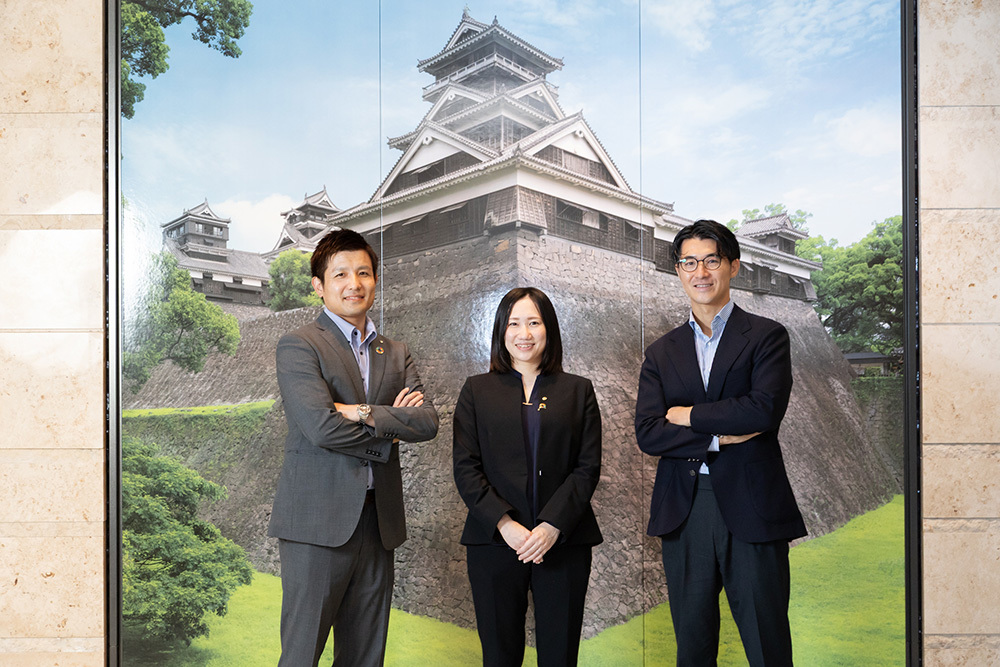
Supporting SMEs' first steps toward decarbonization with an affordable calculation tool
──First, please introduce yourselves.
Nishimura: I belong to the Sustainability Promotion Office within Higo Bank's Management Planning Department, handling tasks related to SDGs and management quality. This work extends beyond Higo Bank itself to include initiatives for regional customers. For the Tansaku-kun Project, I served as the main person in charge, leading planning, development, and promotion.
Tamaki: I also work in the Sustainability Promotion Office as Deputy Planning Officer. Nine members from our office were involved in the Sumikiri-kun Project, and I served as Project Manager, coordinating and directing the team.
Makidani: Dentsu Inc.'s First BX Bureau supports clients through consulting and other services beyond advertising. For this project, we provided support through teams like the Strategy Planning Team and Promotion Team. I was responsible for overall coordination and direction on the Dentsu Inc. side.
──Could you tell us about the background behind Higo Bank, a regional bank, deciding to develop a tool for calculating corporate CO2 emissions? Could you also discuss the challenges faced by client companies and Higo Bank itself in their decarbonization efforts?
Tamaki: Even within the same region, the level of engagement with SDGs and decarbonization efforts varies significantly. According to a 2024 survey by Teikoku Databank, Kumamoto Prefecture ranked first among prefectures for SDG initiative, and we believe this is largely due to the region's collective efforts.
In 2021, our bank established the "Kumamoto Prefecture SDGs Registration System" in collaboration with the prefectural government. For client companies wishing to advance their SDGs and decarbonization efforts using this system, we provide support through "SDGs Consulting" and "Carbon Neutrality Consulting."
To date, we have supported approximately 300 companies through our consulting services. In recent years, we have seen a growing number of clients expressing concerns about decarbonization,
"We don't know where to start with decarbonization efforts,"
"There are various calculation tools, but they all have high usage costs and are difficult to implement."
The first step toward decarbonization is understanding your company's CO2 emissions. Some clients had been calculating emissions using Excel or similar tools, but the "emission factors" required for these calculations are often updated multiple times a year. This frequently leads to human error and increases the workload.
This led us to develop our own calculation tool. We believed that offering it to customers at a low cost could contribute to achieving regional carbon neutrality, and thus the Tansaku-kun Project was launched.
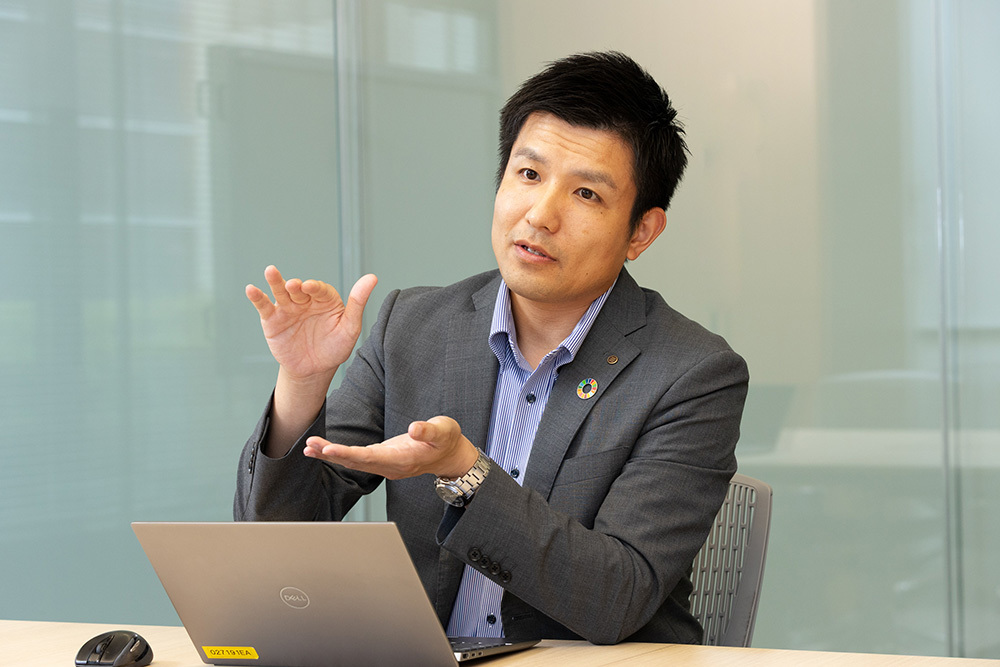
Going Beyond "Financial Support": The Significance of Regional Banks Leading the Charge in Decarbonization
──Amid regional support becoming a major role for local banks, did you particularly feel the importance of promoting decarbonization and SDGs?
Nishimura: Yes, that's correct. Higo Bank's purpose statement is: "We exist to create the future of our region by nurturing, protecting, and passing on our customers' assets and businesses, as well as the region's industries, nature, and culture, together with our customers and the local community."
While we are a financial institution, we deliberately avoid using the word "financial" because we aim to be a group that pursues all possibilities beyond finance and contributes to solving regional challenges. Our president always says, "The future of a region changes depending on what kind of financial institution it has." That's precisely why we believe we must support our customers and protect and nurture the region not only by providing financial support as a bank, but also through activities beyond the banking sector. That's why we have assigned a total of 15 members to the Sustainability Promotion Office.
Tamaki: That said, the finance aspect remains a particular bottleneck for SMEs in SDG initiatives. Our strength lies in being able to support them on this front as well. We start by "measuring" CO2 emissions, then move into the phase of considering how to reduce them. For instance, when a company updates its equipment to lower-emission alternatives or considers switching to sustainable raw materials, funding issues cannot be ignored.
Once companies understand their CO2 emissions using Sumikiri-kun, the next step is identifying the primary drivers of increased emissions—whether it's electricity usage or company vehicle gasoline consumption. Our bank can guide them on reduction methods tailored to these hotspots and their specific circumstances, while also providing comprehensive support for the necessary funding. We envision Sumikiri-kun serving as the hook to initiate this process.
Makita: For SMEs, advancing initiatives in areas like this that don't directly impact profits is particularly challenging due to funding constraints. Someone needs to take the lead and drive these efforts forward, and we believe regional banks are well-positioned to fill that role.
Among them, few banks or companies in other industries allocate as many personnel to sustainability as Higo Bank does. Furthermore, the fact that they are developing such tools in-house is quite a rare case. Decarbonization is also a very important agenda for Dentsu Inc. Supporting regional banks' SDGs initiatives, like this project, holds significant meaning.
For just ¥2,200 per month, it even handles Scope 3 calculations! Discover the appeal of "Tansaku-kun," used by over 4,000 companies—including those implementing it across their entire supply chains.
──Please explain the overview and unique features of Tansaku-kun.
Nishimura: The key point is undoubtedly the price aspect, which was a major challenge for many SMEs.
With Sumikiri-kun, you can measure Scope 1, 2, and 3*, and the monthly fee is just ¥2,200 regardless of how many locations you register (up to 5 IDs). Functionally, it's comparable to other tools. Simply input your company's electricity, gasoline, and other consumption data via PC or smartphone, and it visualizes your CO2 emissions as shown below.
※ Scope 1, 2, 3: "Scope" refers to the range of measurement for greenhouse gas (GHG) emissions like CO₂. Broadly categorized as follows:
・"Scope 1"
GHG "directly emitted" by companies/organizations through fuel combustion, product manufacturing, etc.
・"Scope 2"
GHG indirectly emitted by using electricity, heat, or steam supplied by other companies
・"Scope 3"
GHG emissions occurring throughout the supply chain, such as during raw material procurement for company operations or post-sales activities
① Calculation and visualization of total CO₂ emissions from all corporate activities (Scope 1, 2, 3)
② Setting emission reduction targets and managing progress
③ Reporting of calculation results
④ Management of emissions across the group and entire supply chain


Nishimura: Currently, over 4,000 companies use our service, including more than a dozen Prime-listed companies. Even for listed companies, Scope 3 cannot be calculated solely by the company itself. If small and medium-sized suppliers also use Tanekiri-kun, that data can be linked within the system and directly used for the company's own Scope 3 calculation. While initially developed as a tool for SMEs, an increasing number of listed companies are now utilizing data collected from suppliers via Tanekiri-kun for their own supply chain emissions calculations.

Makita: Tanekiri-kun is affordable yet functionally comparable to competing tools. As mentioned earlier, I believe this is precisely because Higo Bank developed it not to profit from system usage fees as a business, but solely as an entry point to advance decarbonization among regional companies.
While a listed company alone could implement a more costly tool, recommending expensive tools to suppliers becomes difficult when trying to integrate the same tool across the entire supply chain and link data. With Sumikiri-kun costing only 2,200 yen per month, it's much easier to encourage widespread adoption.
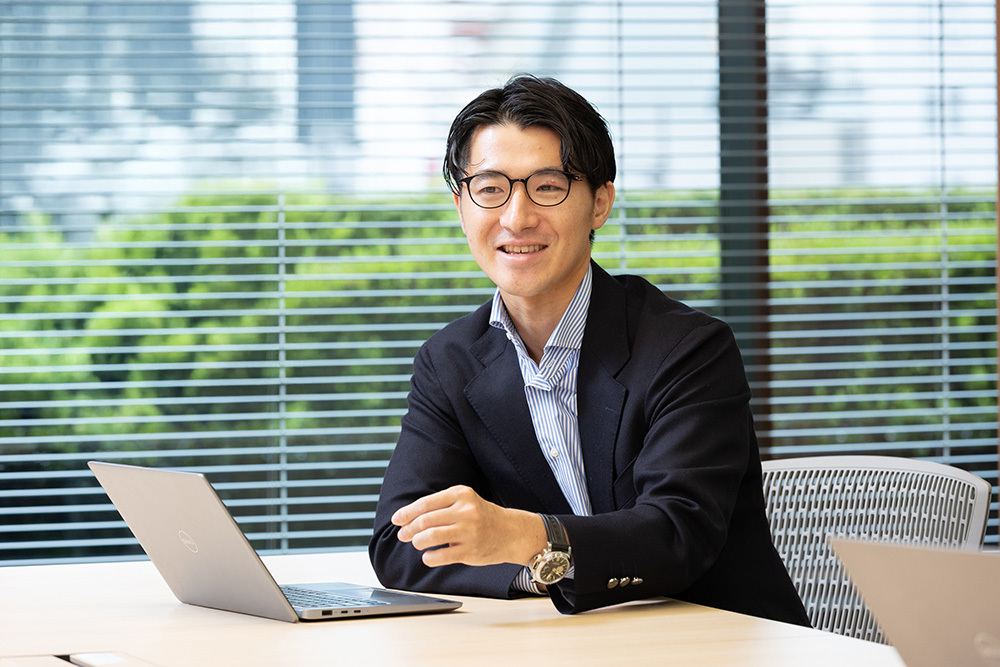
A new feature developed to collaborate with financial institutions nationwide
──I understand Tanekiri-kun offers features designed to be user-friendly not only for SMEs but also for regional financial institutions like your bank. What are these features?
Nishimura: For financial institutions, within Scope 3, emissions from "investee companies" (Category 15) constitute the largest share. For example, at Higo Bank, 90% of the CO2 emissions it bears are from its investee companies. This means that without properly calculating the emissions of client companies, it's impossible to advance carbon neutrality. To help financial institutions track their investees' emissions while working toward regional carbon neutrality, we later added the FE (Financed Emissions) feature to Sumikiri-kun.
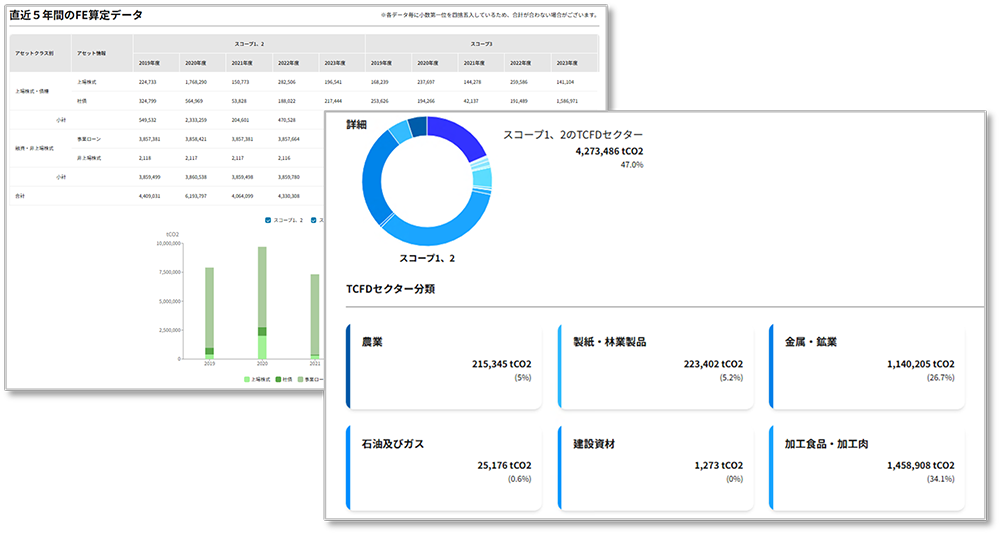
Tamaki: This feature was added based on a proposal from Mr. Makitani. Financial institutions deal with a wide range of clients, many of which cannot calculate their own CO2 emissions. Therefore, for this category, financial institutions must estimate emissions by multiplying figures like sales volume or outstanding loan balances. To reduce the CO2 from this category, which accounts for 90% of their own emissions, they need to know their clients' actual data and require a function to properly calculate it.
Nishimura: Initially, we developed this for SMEs within Kumamoto Prefecture. However, midway through, we began considering its adoption and utilization by financial institutions in other prefectures as well. The reason is that achieving carbon neutrality in each region requires a perspective that considers, for example, "measures that can be advanced together with local governments" based on data calculated by customers. By having financial institutions in other prefectures adopt Tanekaku-kun as a white-label solution and then promoting its adoption among local companies, we believed similar initiatives could be replicated outside Kumamoto Prefecture.

Tamaki: We refer to financial institutions that introduce "Tan-kaku-kun" in other regions and roll it out to local businesses as "Partner Banks." Currently, Fukuoka Bank, Kagoshima Bank, and Tohoku Bank are Partner Banks, and we aim to add at least five more banks within this year.
Achieving carbon neutrality goals is impossible if only Kumamoto Prefecture advances. In that sense, collaborating with financial institutions nationwide offers significant benefits for us. We can share our own challenges in promoting decarbonization within our own bank and region, along with our accumulated know-how and examples of both successes and failures, enabling us to provide support from a closer perspective. Furthermore, we are enhancing our services, such as having Higo Bank handle all help desk support for companies that adopted "Tansaku-kun" through partner banks' referrals.
Through thorough information gathering and analysis, we clearly defined "Tansaku-kun's" positioning. What was the strategy that led to its adoption by approximately 4,000 companies?
──Please tell us why you asked Dentsu Inc. to set the strategy and handle promotion for the nationwide rollout of "Tan-kaku-kun."
Nishimura: As a regional bank, Higo Bank had virtually no prior experience proposing and rolling out a nationwide service like "Sumikiri-kun." We wanted to do it, but didn't know how. The fundamental approach for regional banks launching services is to meet customers directly and engage in dialogue. Targeting the entire nation, however, meant proposing products to customers we had never met, making this method impractical. Therefore, we reached out to Dentsu Inc., who possess extensive expertise in nationwide rollouts and could advise us on effective sales strategies and high-impact methods.
──What specific proposals did Dentsu Inc. actually make?
Nishimura: They advised us not just on promotion, but also on how to develop Tansaku-kun into a robust system amidst competing tools, and on selecting the features necessary for the position we aimed to achieve. Naturally, their proposal also included public relations strategies for nationwide regions, leveraging the core strength of Dentsu Inc.
Tamaki: What particularly stood out was how swiftly they handled gathering and analyzing competitor information, handling an enormous volume of data. Based on that information and analysis, they provided significant support in formulating our strategy, including defining Tanekabu-kun's target position. Regarding promotion, while we were thinking "let's just do a commercial for now...", they clearly told us "that would be a waste of money" (laughs).

──What were the key points Dentsu Inc. focused on when providing support?
Makita: We recognized that to compete with other players nationwide developing and offering similar tools, thorough situation analysis was essential. This "situation" encompassed not only competing tools but also the financial institutions and end-user companies utilizing them. Only by understanding their circumstances could we formulate Tanekiri-kun's sales strategy and positioning. While fundamental, we spent about two months thoroughly conducting initial analysis and diagnostics. This included not only online research but also gathering direct feedback.
Nishimura: Of course, other tools have features that Sumikiri-kun lacks. In those cases, we sometimes get requests like, "Please add that feature." However, Dentsu Inc. accompanied us throughout the process, helping us maintain a bird's-eye view to ask, "Considering Sumikiri-kun's users and purpose, is adding that feature truly necessary?"
We prioritized features based on Sumikiri-kun's target position and sales strategy, discussing repeatedly whether they were truly necessary. Their advice on which areas would be stronger if developed in-house versus where partnering with other tools would be more advantageous was invaluable. Since we were committed to keeping the price unchanged, this allowed us to make informed trade-offs within that constraint.
While Sumikiri-kun itself launched in January 2024, I believe we wouldn't have reached approximately 4,000 companies within a year if we hadn't developed a strategy based on Dentsu Inc.'s analysis between April and September.
After "visualization," we need actionable reduction plans! Even as conditions change daily, we want to create a nationwide decarbonization movement in Japan.
──Could you share your thoughts on future developments? Also, please tell us what Higo Bank expects from Dentsu Inc.
Tamaki: Tan-kaku-kun is fundamentally a tool for "calculating" and "visualizing" CO2. Achieving carbon neutrality isn't just about visualization; it requires actual "reduction" to be meaningful. Therefore, moving forward, we aim to add functionality that leverages AI and other technologies to propose achievable reduction measures tailored to each company.
The landscape surrounding decarbonization is changing daily, both for our client companies and in terms of national policy. Amidst this, both Tanekiri-kun itself and our strategy must be constantly refined. Dentsu Inc. possesses extensive knowledge and experience in this field, so we want to continue consulting with them, leveraging their latest insights alongside their expertise. We also intend to keep our antennae tuned high as we drive this forward.
Nishimura: As one of Japan's leading companies, we expect Dentsu Inc. not only to provide us with information but also to help create a broader movement to advance decarbonization across Japan.
Makita: Thank you. Efforts toward decarbonization are clearly polarized across regions in terms of progress. Dentsu Inc.'s strength lies in its ability to create momentum not only with consumers but also through its diverse client connections, leveraging its B2B perspective. We aim to continue driving decarbonization by organizing groups with client companies to promote decarbonization and by creating momentum.
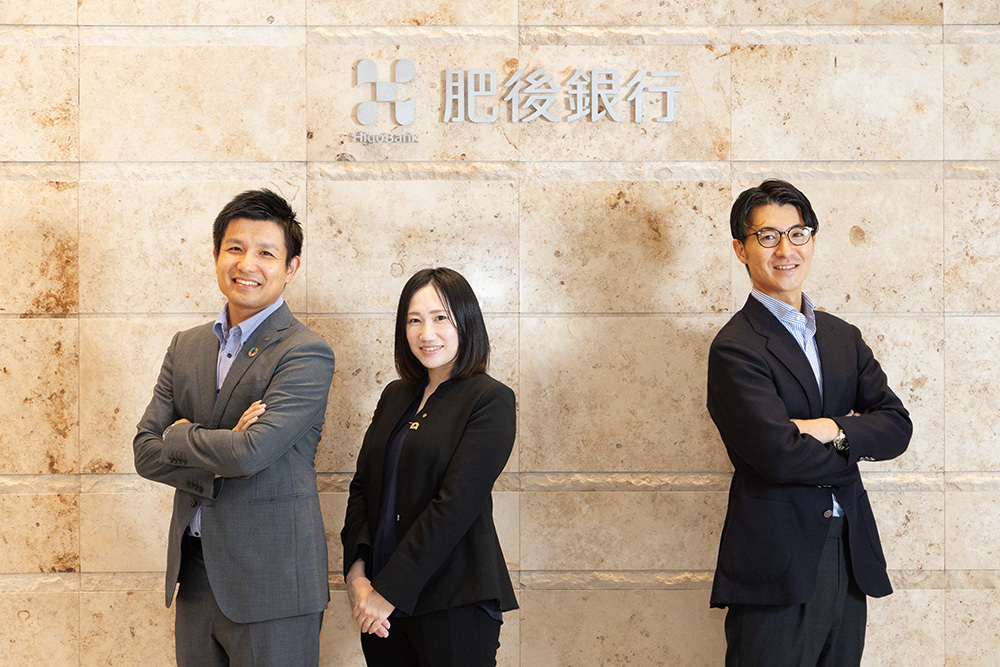
Was this article helpful?
Newsletter registration is here
We select and publish important news every day
For inquiries about this article
Author

Takajiro Tamaki
Higo Bank
After joining Higo Bank in 2007, he worked in branches and the Human Resources Department before joining the Sustainability Promotion Office within the Corporate Planning Department in 2022. As the leader of the "Sumikiri-kun" project, he was involved in naming and planning its promotion, playing a key role from its inception. He continues to strive for the further growth and nationwide expansion of "Sumikiri-kun," aiming to realize a sustainable society.

Nami Nishimura
Higo Bank
Joined Higo Bank in 2012. After two years in branch operations, transferred to the Corporate Planning Department, where she engaged in cross-functional planning tasks including mid-term management planning. Since 2023, she has been promoting the Sumikiri-kun Project in her current position. Privately, as a mother of one, she devotes herself to raising her child while also watching over Sumikiri-kun's growth, just as she would her own child.

Yoshihiro Makitani
Dentsu Inc.
After working at a foreign-affiliated general consulting firm and a foreign-affiliated strategy consulting firm, he joined Dentsu Inc. At Dentsu Inc., he supports clients in formulating new business initiatives, developing sales strategies, and addressing sustainability-related matters.

